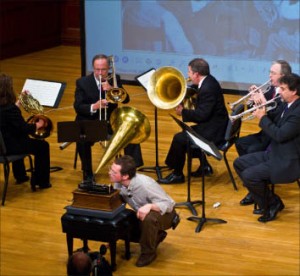
By Kelly Davila
Correspondent
From Thomas Edison to Dr. Dre, the way music is being heard is constantly changing. Last Thursday Sept. 23, Jerry Fabris, curator for the Thomas Edison National Historical Park Museum, visited the College for a presentation on “19th Century Origins of Audio.” Equipped with the earliest recording instruments and a demonstration band, Fabris walked the audience through Edison’s tactics in manufacturing what would be the stepping-stone for audio distribution.
Fabris became the museum curator in 1994, and has since been researching early audio-based mediums. This includes the phonautograph, telegraph and Edison’s phonograph from 1877. With pictures and instruments provided in the presentation, students were able to understand more about the machines.
“I’ve always loved music and that got me interested in audio … later on, in its history,” Fabris explained as to why his interest in the age-old device grew.
The main focus of the presentation was Edison’s phonograph. The device functions by engraving sound vibrations from the cone-shaped receptor into a warmed wax cylinder with a thin needle, which is then played back by passing over the engravings.
Being the businessman that he was, Edison searched for ways to turn the recordings into a business venture — basically, making a lot of money off recording audio. With today’s media industry, Edison got his wish.
Fabris played a musical recording made by Edison in 1888. By transforming the wax engravings into an mp3 file, Fabris made this possible.
With the accompaniment of the TCNJ Faculty Brass, consisting of professors James Hala on trumpet, Robert Gale on trombone and Brian Brown on tuba, and alumna Kristina Gannon on French horn, and an estimated three-foot phonograph from the 20th century, Fabris recorded the band’s rendition of “The Entertainer.”
Fabris placed the wax cylinder into the playback machine with a knowing grin. Smiles broke out across the audience as the play back was heard — to see and hear sound the way it had been heard over a century ago.
“The field of audio recording is always evolving and it was really neat to see where it all started out,” said freshman music education major Brian Chesney. “I really want to keep my opportunity’s open in the area of audio recording because it has always been an interest of mine.”






